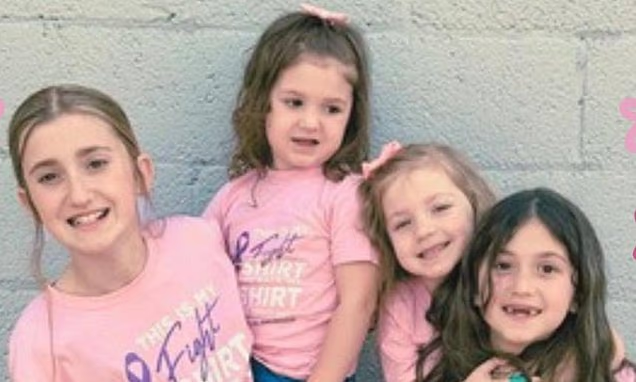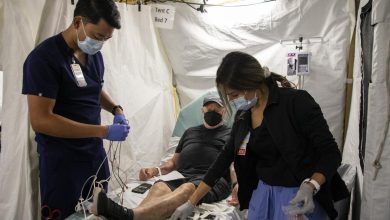Four Sisters, One Diagnosis: The Rare Brain Disorder That Changed Their Lives

When four American sisters began experiencing mysterious health issues—ranging from headaches and dizziness to sudden numbness and muscle weakness—none of them could have imagined that their lives were about to change forever. What started as a string of isolated symptoms soon revealed a shocking truth: all four were living with the same rare brain disorder known as Chiari malformation, a condition that affects how the brain and spinal cord interact.
Their shared diagnosis has not only transformed their understanding of health and heredity but also ignited a journey of resilience, advocacy, and hope for others facing similar struggles.
This is the extraordinary story of four sisters, one diagnosis, and a lifetime of perseverance against the odds.
The Beginning: Mysterious Symptoms No One Could Explain
It began subtly—an occasional dizzy spell here, a strange pressure headache there. The eldest sister, Amanda, 32, brushed off her symptoms for years, assuming they were stress-related. But when her younger sister Jessica, 29, began experiencing similar issues—along with severe neck pain and tingling in her hands—the family started to suspect something more serious.
“I thought it was just tension headaches,” Amanda recalls. “But when Jessica started fainting out of nowhere, we realized this couldn’t be normal.”
Soon, their younger siblings, Lauren, 26, and Megan, 23, also reported similar problems: blurred vision, ringing in the ears, and moments where they felt as though the room was spinning. One by one, the sisters began to see neurologists, hoping for answers.
After months of inconclusive tests and growing frustration, a single MRI scan provided the missing piece of the puzzle. The results revealed that Amanda had Chiari malformation, a rare structural defect in the base of the skull that causes brain tissue to extend into the spinal canal.
And as more scans followed, the shocking truth emerged: all four sisters shared the same diagnosis.
Understanding Chiari Malformation
Chiari malformation (pronounced kee-AH-ree) is a neurological condition where the lower part of the brain—the cerebellar tonsils—descends into the spinal canal. This abnormality disrupts the normal flow of cerebrospinal fluid, leading to pressure on the brainstem and spinal cord.
There are several types of Chiari malformations, but Type I is the most common form and often goes undiagnosed until adolescence or adulthood. In severe cases, it can lead to paralysis, chronic pain, or balance and coordination issues.
Symptoms vary widely and may include:
- Persistent headaches (especially after coughing or straining)
- Neck pain
- Numbness or tingling in the hands and feet
- Difficulty swallowing
- Vision or hearing problems
- Problems with balance and coordination
The condition can be congenital (present at birth) or acquired due to injury, infection, or spinal fluid imbalance. While the exact cause is still not fully understood, genetics appear to play a significant role—something the sisters’ case clearly underscores.
“It’s incredibly rare for four siblings in the same family to be diagnosed,” says Dr. Karen Lewis, a neurologist specializing in structural brain disorders. “This strongly suggests a hereditary component, and cases like this are helping researchers understand how genetics may influence Chiari development.”
The Emotional Toll of a Shared Diagnosis
When the fourth sister received her diagnosis, the family’s reaction was a mix of relief and disbelief.
“At first, I felt angry,” Megan admits. “It was like we were all carrying this invisible burden and no one knew why.”
The diagnosis finally gave their pain a name, but it also brought new fears. Would they all need brain surgery? Would their symptoms get worse? And how would this affect their ability to live normal lives?
Each sister’s experience with Chiari malformation has been unique. Amanda’s headaches and balance issues are severe enough that she had to quit her teaching job. Jessica’s fainting spells once caused her to collapse in a grocery store. Lauren struggles with chronic fatigue, while Megan experiences painful neck stiffness that sometimes leaves her bedridden.
“I used to love running,” Lauren says softly. “But now, even walking too fast makes me dizzy.”
The emotional toll has been immense. Living with an invisible illness means facing skepticism from others and constant uncertainty about the future. Yet, having one another has been a source of strength.
“When I have bad days, I text my sisters,” Jessica explains. “They understand in ways no one else can. We’ve built our own support system.”
Navigating Treatment: Surgery, Therapy, and Adaptation
Treatment for Chiari malformation depends on the severity of symptoms. In mild cases, doctors may recommend monitoring, physical therapy, and pain management. But for more severe cases—especially when cerebrospinal fluid flow is obstructed—surgery is often the only option.
Amanda and Jessica both underwent posterior fossa decompression surgery, a procedure designed to relieve pressure at the base of the skull and restore normal fluid movement around the brain and spinal cord.
“It was terrifying,” Amanda recalls. “The thought of someone operating on my brain was overwhelming. But after surgery, I finally felt relief from the constant pressure in my head.”
Jessica’s surgery was more complicated. She developed complications that required additional hospital stays and months of rehabilitation. “There were days I wondered if I made the right choice,” she says. “But my sisters reminded me I wasn’t alone.”
Lauren and Megan opted for conservative management—physical therapy, medication, and regular monitoring. Their doctors are cautious, as surgery isn’t without risk.
Dr. Lewis emphasizes that there’s no “one-size-fits-all” solution for Chiari malformation: “Each case is different. Some patients may live symptom-free for years, while others need multiple surgeries. What matters most is personalized care and ongoing monitoring.”
Life After Diagnosis: Redefining Normal
For the four sisters, life after diagnosis has been a process of adaptation. Everyday activities now require more planning and patience.
Amanda has become an advocate for Chiari awareness, speaking at local hospitals and support groups. Jessica, who once felt isolated by her illness, now runs an online community for others living with the condition. Lauren has turned to yoga and mindfulness to manage pain, while Megan, the youngest, focuses on raising awareness in schools about invisible illnesses.
“I used to feel like my condition defined me,” says Megan. “Now, I see it as part of my story—but not the whole story.”
Their parents, too, have played a critical role. “Watching all four of our daughters go through this was heartbreaking,” their mother, Susan, shares. “But we’ve learned that strength runs in families just like genes do.”
Together, the family celebrates small victories—like symptom-free days or successful follow-up scans—and supports one another through setbacks.
The Role of Genetics and Research
Cases like the sisters’ are rare but invaluable to medical science. Researchers studying familial Chiari malformation are beginning to identify potential genetic markers that may predispose individuals to the disorder.
Dr. Lewis and her team have been studying families like theirs to understand how genetic mutations might influence skull structure and cerebrospinal fluid flow. “We believe there may be a hereditary connective tissue component,” she explains. “If we can pinpoint the genetic pathways, we could improve early detection and develop targeted therapies.”
Currently, Chiari malformation affects roughly 1 in 1,000 people, but many cases remain undiagnosed due to vague or overlapping symptoms. Improved imaging technology and growing public awareness are helping more patients find answers earlier—something that could have spared the sisters years of uncertainty.
Amanda recently participated in a genetic research study, donating DNA samples to help future generations. “If our story can help someone else get diagnosed faster,” she says, “then all the pain we’ve endured will mean something.”
Living with an Invisible Illness
One of the biggest challenges for people with Chiari malformation is the invisibility of their symptoms. From the outside, they may appear perfectly healthy. Inside, they may be battling constant headaches, vertigo, or brain fog.
“People don’t realize how debilitating it can be,” Jessica says. “When I tell people I have a brain disorder, they’re shocked because I ‘look fine.’ But they don’t see the pain behind my smile.”
The sisters often emphasize the importance of compassion and awareness—not just for Chiari malformation but for all invisible illnesses. Their message: just because you can’t see it doesn’t mean it isn’t real.
To cope, the sisters rely on lifestyle modifications such as:
- Prioritizing rest and managing stress
- Avoiding activities that increase pressure in the head (like heavy lifting or straining)
- Practicing gentle exercises like swimming or stretching
- Maintaining proper posture and neck alignment
- Using migraine and pain management therapies
They’ve also found strength through online communities where thousands of people share their stories, advice, and support. “It’s comforting to know we’re not alone,” Lauren says. “There’s a whole world of Chiari warriors out there.”
Raising Awareness and Giving Back
Motivated by their experiences, the sisters have become passionate advocates for Chiari awareness. Each September, they participate in Chiari Awareness Month, organizing fundraisers and educational events to raise money for research.
Last year, they hosted a virtual walk-a-thon that attracted participants from across the country and raised thousands of dollars for the Conquer Chiari Foundation.
“Our goal is to make sure no one has to go years without answers like we did,” Amanda explains. “Awareness saves lives.”
They also use social media to share resources, recovery updates, and candid reflections about life with Chiari. Their joint Instagram page, @FourSistersStrong, has attracted a large following from others navigating chronic illnesses.
Through advocacy, they’ve turned their pain into purpose—and their shared struggle into a message of hope.
Looking Ahead: Hope Through Research and Resilience
While Chiari malformation remains a lifelong condition, advances in neurosurgery, genetics, and imaging are offering new hope. Minimally invasive surgical techniques, better pain management strategies, and personalized treatment plans are improving outcomes for patients worldwide.
Dr. Lewis believes the future is bright: “As we continue to understand the genetic and structural causes of Chiari malformation, we move closer to earlier diagnosis, better treatments, and improved quality of life for patients.”
For the sisters, hope is what keeps them moving forward.
“Some days are harder than others,” Amanda admits. “But knowing that we have each other—and that we’re helping others through our story—makes it worth it.”
Their bond has only grown stronger through their shared journey. They’ve learned to celebrate resilience, find beauty in the struggle, and cherish the gift of understanding that can only come from walking the same difficult path together.
Conclusion: Four Sisters, One Unbreakable Bond
What began as a frightening mystery has become a testament to the power of family, faith, and perseverance. The story of four sisters, united by a rare diagnosis, reminds us that even the most difficult challenges can reveal extraordinary strength.
Their journey sheds light on the importance of listening to your body, advocating for your health, and finding solidarity in shared experience.
Chiari malformation may have changed their lives—but it also connected them in ways that go beyond biology.
As Amanda puts it, “We didn’t choose this journey, but we’re walking it together. And together, we’re stronger than Chiari.”




